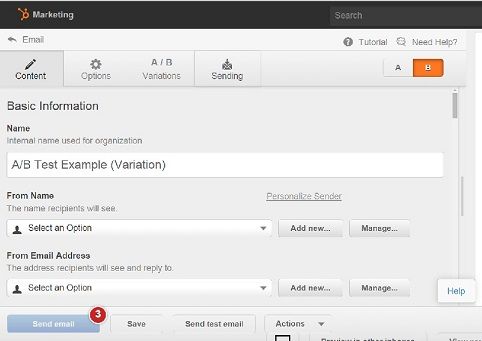If you’ve ever hung a picture frame in your home (and you’re not an interior designer), perhaps you’ll know the feeling I’m about to describe. You tweak the height. You adjust the angle a bit. You try backing up a few paces to get a new perspective. Inevitably, though, the exercise ends in frustration. You’ve sweated through your shirt, the picture frame is somehow still slightly slanted, and (if you’re like me) your thumb has been hammered into a pulpy mess of indeterminate shape and color.
When small, design-based decisions like these become a source of frustration, it’s tempting to just scrap the idea altogether and throw the picture frame back under the bed. When it comes to your business’ web presence though, it’s important (and relatively easy, as we will learn) to fight against that urge. Instead, use A/B testing to make these design choices as seamless and rewarding as possible. Your website – and your revenue stream – will thank you.
So What Exactly Is A/B Testing and How Can It Help Your Website?
Full disclosure: when I first learned about A/B testing as a digital marketing method, I was skeptical. It seemed too reductive to really be effective for a small business owner. I thought that the samples of data would be too small to bring significant results.
I couldn’t have been more wrong. As A/B testing can often prove (appropriately enough), first impressions often don’t stand up to the gauntlet of empirical evidence.
HubSpot defines A/B testing as “the process of comparing two variations of a single variable to determine which performs best in order to help improve marketing efforts.”
Now, you might be asking yourself, “What makes this any different from a basic definition of a scientific research experiment?” And you’d be right. The whole point of A/B testing is to take those core concepts of experimental research and apply them to optimizing your website and achieving your digital marketing goals. Specific to web design, A/B testing also provides the advantage of validating your data ahead of time, so you don’t have to do major coding grunt-work without knowing that it will be beneficial.
As we mentioned, the method has its roots in the simplest forms of scientific research. Two variables are trotted out onto the playing field, the results are tracked and catalogued, and a decision between the two is made based on those results. Usually the first, or control variable, will be representative of your website (or some particular element of your website – a call-to-action, a color scheme, etc.) as it stands now. Another one will represent a potential change, or the experimental variable.
What makes the technique so useful in the world of web design is the efficiency with which results can be documented. The activities of your website’s visitors aren’t going to be obscured by factors out of your control that might affect a more traditional experiment: human error, research bias, etc. Instead, the data will be fully streamlined so your site’s optimization occurs in real time, right in front of your eyes.
An important pitfall to avoid would be to assume that A/B testing deals exclusively with deciding which content to add to your website. In fact, as any experienced writer would tell you, often the most important improvements are those you arrive at via subtraction. The next time you’re wondering why a CTA isn’t converting at the rate you would hope, ask yourself if there’s any surrounding bits of content that could be distracting your site’s visitors. If it looks like there might be, try an A/B test to see if the CTA does a better job of conversion when it’s left by itself.
How Can a Small Business Owner like Me Take Advantage of This Concept Without the Technical Know-how of a Web Development Expert?
That’s a great question. As a business owner, there is so much on your plate to begin with, so getting your website up and running is daunting enough without worrying about seemingly insignificant optimization details.
Luckily, there are products out there to help with this. Companies like HubSpot, Optimizely, and Unbounce have software that can all but do this work for you. Automating these processes will make your life easier and your website more effective than ever before. Plus, you’ll be leaving the mundane work to the software, so you can focus on using those easy-to-interpret results to increase profits! (However, if you do want the technical know-how, we know some people who might be able to help.)
Can I Use A/B Testing in My Email Marketing Campaigns?
So we know that email is still an important part of digital marketing campaigns, but is it a good place for A/B testing?
In a word: yes.
Think of emails as little webpages that you’re sending out to people’s inboxes. Just like your website, they have structure, content, and certain goals you’ve ascribed to them. Think about these attributes as you build your e-mail, and then come up with some variables to test against one another. After just a few testing campaigns, your emails’ conversion rates can rapidly improve.
Can Testing Multiple Elements at Once Help Me save Time and Effort?
Recall the phrase from science class, “Correlation does not mean causation”. If you flood your test with more than one variable, you’ll be unable to determine which one caused the result. When you pick an element to test, stick with it for whatever length of time is necessary to garner meaningful results.
However, this doesn’t, mean that you can’t be flexible with what you consider an ‘element’. Some of the most dramatic results can be obtained by using larger-scale A/B testing (testing one entire email against a completely different one, for example). So ultimately, the key is to know exactly what you are hoping to achieve and picking two possible approaches to getting there. Keep whichever one gets you closest and you’re one step closer to a fully optimized web presence!
What Elements of My Website Are Best to Use A/B Testing On?
A/B testing can be used on any number of elements of your website. Since changes can be made so quickly, why not use all the flexibility that’s available to you? Remember that these aren’t new concepts; so a great deal is riding on your ability to be creative when putting them into practice.
1) Color scheme – It may seem like a small decision, but psychologists have shown that color schemes will have an enormous effect on the first impression your website makes. Don’t give yourself the daunting task of trying to guess the perfect combination of colors and hues. Let A/B testing decide for you!
2) Headlines – Like the welcome mat in front of your home, your header will be the first impression a visitor has of your website. Treat it as such and use A/B testing to find out which version of the headline works best for conversion rate.
3) Calls-to-Action – Calls-to-action are possibly the most important element of your site to use A/B testing on. Your CTA’s are your visitors’ portal to becoming a lead. If that doorway isn’t convincing, they’ll move on without thinking twice.
4) Landing Pages – Once they make their way through the doorway, what are they presented with? A landing page that’s inviting enough that they remain convinced that this offer is worth giving some information? Or one that gives them a bad feeling about the whole process, causing them to back away from the page? These questions don’t have to be yours alone to answer. Use A/B testing as your guide and watch your conversion rates improve.
5) Overall Structure – Making a major change to your website’s structure can feel daunting for obvious reasons. Once the structure goes, after all, what else is there? Well, this shouldn’t discourage you from experimenting. A/B testing is a great way to find out if there is something structurally that could be improved. If you get a clear result favoring some revision, your next step shouldn’t be daunting; it should be a relief to know that there is something so clearly needing to be done, and that you have the data you need to get it done effectively. Be bold. As Nike says, Just do it!
6) Word Choice – A/B testing on word choice can be extremely productive for web optimization. It’s hard to believe, but even changing one word can make huge difference for conversion rates. That’s the beauty of A/B testing though, correlations are presented and proven that you may not have even ever considered.
Remember – the ultimate goal of A/B testing is to create less work for you, not more. Embrace the method and you will be rewarded with a website that is constantly optimizing itself. Leave the design decisions up to the people who matter most, your site’s visitors!
With the use of A/B testing on items like calls-to-action, landing pages, and more, inbound marketing is that much more effective in attracting customers to your business. Learn more by downloading our step-by-step ebook, Inbound Marketing Roadmap: 7 Steps to Inbound Success, below!




